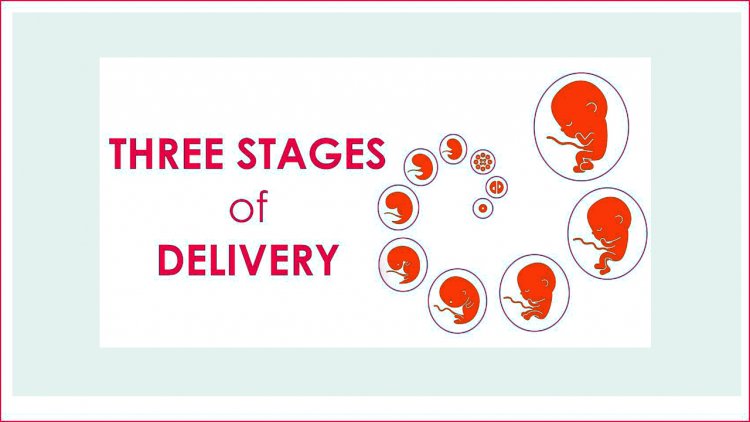Three stages of Delivery
Childbirth is generally divided into three stages. The first stage is the longest for almost everyone, but its length is very variable. Any period between one hour and 20 hours is considered normal. Labor begins as a response to hormonal triggers from the baby. The adrenal gland of the baby develops and starts secreting a hormone called cortisone. In response, the mother secretes hormones called prostaglandins – and these are the hormones that initiate the process of uterine contractions.

Phase 1
With each contraction:
- The uterus pushes the baby down.
- The cervix opens and becomes dilated.
- By the end of the first stage, the cervix is fully opened; Enough so that the baby can come out of it and pass through the genital tract (vagina). It is said to extend up to 10 centimeters or completely.
- How contractions change early in labor, contractions last about 40 seconds, once every 10 minutes. By the end, each contraction lasts more than a minute, with an interval of no more than a minute between each.
With its increase, the speed of the delivery process increases. It normally takes much less time for the cervix to dilate again by five centimeters, compared to the first five centimeters. Most women cope with this stage of labor very well if they feel free to choose the position that feels best to them. These include:
- kneel down
- leaning forward on a cushion on the floor or on your partner's lap
- lean against the wall
- Resting the body on all four arms and legs ... and something that is comfortable - different positions may work for you at different times.
Monitoring your baby's heart
- During labor, fetal health is closely monitored through the measurement of your baby's heart rate.
- The nurse or doctor may use a Pinard stethoscope, which looks like a type of ear trumpet. They will listen to your baby's heartbeat by placing it on your tummy.
- You can be connected to an electronic fetal monitor that detects the baby's heartbeat and displays it on the screen as a number.
- Alternatively, a small electrode is clipped to the skin of the baby's head that detects the heartbeat and the result is sent to the machine. This form of monitoring can be continuous.
- A Doppler machine uses ultrasound for monitoring. A small transmitter-receiver is placed on your abdomen to detect the heartbeat.
Phase 2
The second stage of labor begins when the cervix is fully dilated and ends with the birth of your baby. This phase lasts from a few minutes to a few hours. You'll know you're in the second stage when you feel an intense need to push down. If you have been given an epidural, you may not feel it as intensely or at all. This pushing is called 'bearing down'. The nurse or your doctor will tell you what to do if you can't feel it.
Bare down may require you to hold your breath; But don't hold it for long. Your nurse/doctor knows better. They may also tell you not to push - perhaps because a small 'lip' of the cervix is still stuck. When the lip expands, you are ready to push.
They may also tell you not to push - perhaps because a small 'lip' of the cervix is still stuck. When the lip expands, you are ready to push. You may be asked to 'pull the baby out with force' with light, slow breaths. Some women do not feel the need to go bare down, even when they have not been given an epidural. The baby comes out easily. This is likely to happen only if you have had a few children.
Seeing your baby for the first time
When the head of the baby is fully visible on the vulva, it is called 'crowning'. If you want, you yourself or your partner can show it to you with the help of a mirror, so you can see the moment. With the next one or two contractions your baby's head comes out first and then the rest of it comes out. Your concerned doctor or nurse will gently lift your baby and place it in your arms or on your stomach so that you can witness this beautiful little miracle.
The best position for you (body position)
Any position in which you feel as comfortable as possible between contractions, and in which your baby can come out safely.
- Your pelvis is fully opened up by squatting with support and your baby comes out with the help of gravity.
- Your upper body needs support to keep your balance. If your partner is strong enough, they can hold you under your arms from behind. Your knees should be no higher than your hips (this will put pressure on your joints).
- A stool or chair will give you support in the half-sitting position. You may also need to be held.
- You get relief from bending forward by resting the body on all four arms and legs between contractions.
- Lying upright is not very effective in childbirth. There is some stretch in your pelvis, and your baby has to move 'upwards' against gravity. A good solution is to sit on the bed and support yourself with lots of pillows, and perhaps the support of your partner.
- If you are tired and are unable to sit in a standing position, then it is comfortable for you to have your upper leg raised on the side position.
The moment of birth
Your baby's head usually turns out to face your back. The midwife may examine your baby's umbilical cord to make sure it is not wrapped around the neck. Then the shoulders are rotated so that the body remains to the side and the head, now outside of you, also turns to the side.
Sometimes forceps are used to push the baby out. The forceps are a set of attached spoons that help hold and remove the baby's head. The Ventos has a vacuum pump that is used to expel the baby. They can be used to help get the baby out more quickly, for example in the following situations:
- if she is unwell - the heartbeat is slow, or if the baby passes meconium (this is the contents of the baby's rectum) which taints the liqueur (amniotic fluid), or if it is taken from the skin of the baby's head visible in the blood sample taken.
- If it is difficult for her to come out because her physical condition may not be right, or the mother's pelvis is not opening completely.
- If your contractions have slowed down, or you're tired, it's important to seek help from the forceps.
- If the baby is premature, it means the soft bones in his head need more protection.
Sometimes the perineum ruptures while pulling the baby's head. Or, the nurse/doctor may ask if they can cut the perineum because they think it is going to rupture badly or if the baby needs to be taken out immediately. If forceps are to be used, they will be cut. This incision is known as an episiotomy. Larger incisions and episiotomies have to be sewn up later. When this is done you will be given a local anesthetic. The stitches will dissolve on their own; You usually don't need to have them removed.
Phase 3
- The third stage of labor is the release of the placenta (placenta or umbilical cord) and membranes. This process starts a few minutes after your baby is born and continues for between 10-20 minutes. You are hardly aware of the existence of this third stage.
- Hormones are usually injected into your thigh or buttock, which prompts the uterus to contract. This injection is given when your baby is born, usually when the first shoulder comes out. The nurse will ask for your consent before doing this.
- Then, as soon as your baby is born, the umbilical cord is knotted and cut.
- The uterus contracts very rapidly and the placenta detaches itself from the inner wall of the uterus. You can push the placenta out, or if you can't, the nurse helps with the delivery of the placenta by placing one hand on your abdomen to protect the uterus while the placenta remains in a taut position with the other.
- With the release of the placenta, the blood vessels attached to it close and stop the flow of blood (although some bleeding is normal).
- A third physiological stage – in which injections are not used and waiting for the placenta to be cut and delivery of the placenta is not assisted – is when your doctor decides to let things happen naturally.
- The act of breastfeeding the baby or simply keeping the baby there triggers the release of the hormone oxytocin. It acts on your uterus which then contracts and expels the placenta and membranes. The placenta is cut when it stops pulsating and usually when the placenta has come out.
- If you want the natural third stage option, then tell your caregivers and talk about it before going for the delivery. If you have problems during your pregnancy or during labor, natural third stage may not be a safe option for you.

 mybabycare
mybabycare 













![Implantation Bleeding With Twins [How Long Does IB Last With Twins?]](https://blog.mybabycare.co.in/uploads/images/2022/02/image_380x226_61fac4f48ca76.jpg)

